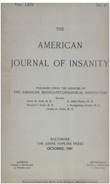NEW ENGLAND SOCIETY OF PSYCHIATRY
Abstract
1. We cannot but regard Alzheimer's as the best method yet devised for the cytological study of the cerebro-spinal fluid, the good results depending upon rapid fixation of the cells and the subsequent treatment of them as if they were tissue.
2. A good differential count and a fair quantitative count are possible by this method.
3. The cells regarded by us as of greatest diagnostic importance are the plasma cell, the phagocytic endothelial cell, the fatty granule cell, and the lymphocyte if in excess.
4. In psychiatry the cell picture in general paralysis stands out distinctly from that of the other forms of insanity, the latter being considered by us as nearly normal fluids.
See table in the PDF file
A high cell count, with excess of lymphocytes, over 100 to 100 fields, the presence of plasma cells and perhaps phagocytes in a case of suspected general paralysis is the strongest evidence in favor of this diagnosis.
5. It is possible that other organic cerebral conditions may show a cell picture of diagnostic importance, as indicated by the finding of fatty-granule cells in these conditions post mortem.
6. The origin of the cells in the fluid is without doubt in large measure if not entirely traced to the pia mater.
Access content
To read the fulltext, please use one of the options below to sign in or purchase access.- Personal login
- Institutional Login
- Sign in via OpenAthens
- Register for access
-
Please login/register if you wish to pair your device and check access availability.
Not a subscriber?
PsychiatryOnline subscription options offer access to the DSM-5 library, books, journals, CME, and patient resources. This all-in-one virtual library provides psychiatrists and mental health professionals with key resources for diagnosis, treatment, research, and professional development.
Need more help? PsychiatryOnline Customer Service may be reached by emailing [email protected] or by calling 800-368-5777 (in the U.S.) or 703-907-7322 (outside the U.S.).



